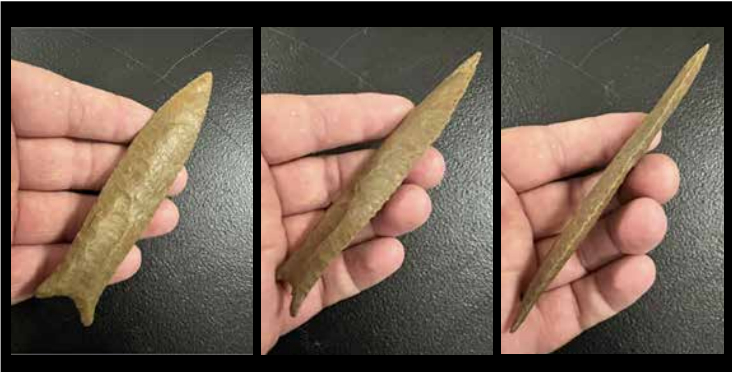|
The Story of the Red Moon Cumberland
|
by Jacob Tucker |
| Central States Archaeological Societies 2025 October Journal |
Nettleton, Mississippi |
| |
|
|
This excerpt from "The Story of the Red
Moon Cumberland" published
in the 2025 Central States Archaeological Societies 2025
October Journal
Read the complete column in the Central States
Archaeological Societies 2025
October Journal which can be purchased on-line after March 2026 |
 |
Figure 1. Three views of the perfect 4 ?” fluted
Cumberland point found by Charles Hardy. This article originally appeared
in
the Magnolia Archaeological Society Newsletter.
Collection of theTim Guyse, Courtland, Alabama
|
Probably the most iconic of all eastern American Indian artifacts are large,
finely made Cumberland points. Examples like the 6?” (Charles) Moore
Cumberland that was found in Colbert County, Alabama in 1963, and the “Christmas
Star” found by a diver in the Tennessee River in the 1990s, are
widely acclaimed as gems of ancient lithic craftsmanship. They are especially
noteworthy for their outstanding flaking and fluting, often nearly to
the tip on at least one side. When Cumberland points of such quality are
exhibited they steal the show. Only rarely does a new point of such caliber
appear.
Such was the occurrence at the January 18, 2025 St Joseph, Tennessee artifact
show. An outstanding 4 ?” fluted Cumberland point made from beautifully
brown patinated Fort Payne chert (Figs 1-3) was brought in as the personal
find of an occasional hunter and casual collector named Charles Hardy.
Charles related the story of its discovery to me as follows: A friend of
Charles’ was recently digging a pond in front of his house that is
near Four Mile Creek in Limestone County, Alabama. Charles heard rumors that
some arrowheads had been found in the excavations. He had just enough interest
in relics to approach his friend and ask for permission to look for himself.
After work on September 19, 2024, Charles, for the second time, asked the
friend if he could look around the site for arrowheads. The response this
time was, “OK, but you gotta give me whatever you find. Not expecting
to find much anyway." Charles agreed. This was after work so daylight
was soon fading. As darkness fell upon the site Charles discovered that the
bright moonlight of the Red (or blood) Moon of the season provided enough
light for him to look on just a while. In fact, he noticed that flint was
shining or glistening by the light of the moon. Just as Charles was calling
it quits and heading back to his friend’s house he spotted...
Read other great columns in the Central States Archaeological Societies 2025
October Journal which can be purchased on-line after March 2026
|
|




